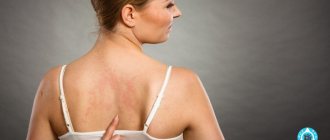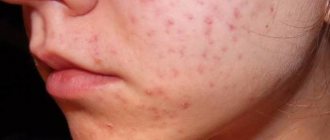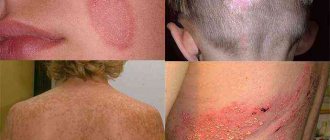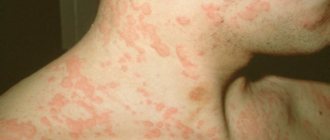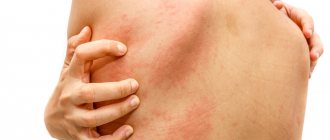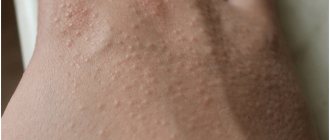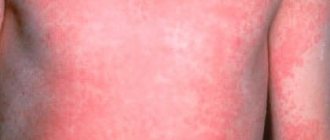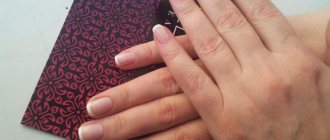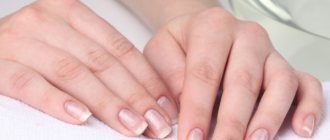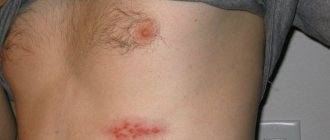Why does redness appear on the skin?
Some patients, not rushing to consult with specialists, mistakenly consider skin allergies to be a harmless pathology. Red spots itch, increase in size and spread throughout the body. Under no circumstances should this symptom be ignored. The very presence of external manifestations indicates the impact of the irritant, which, in order to avoid complications, it is advisable to eliminate as soon as possible.
Human skin is an objective indicator of the general condition of the body. The appearance of any defect on the epidermis, not associated with the influence of any external factors, reflects a hidden health problem. Red spots due to allergies in themselves are not considered a serious pathology, although they can cause many problems, complicating the course of the disease. Of particular importance is their localization and severity, which make it possible to determine the causes of occurrence and draw up a plan for further therapeutic measures.
How it manifests itself
Signs of allergies on the face vary from mild itching or minor redness to the appearance of large, painful blisters on the skin that are prone to spreading. Because of this, it can be quite difficult even for a specialist to promptly and reliably recognize the pathological process. Therefore, below are the most common primary symptoms indicating the development of an allergy. These include:
- The appearance of small pink or red spots on the face, no larger than the head of a sewing needle. Indicates a mild allergic process or its initial stage. It can go away on its own, but if it spreads to other parts of the body or transforms, drug treatment is needed. Also, spots can progress to subsequent stages of skin allergic manifestations.
- The manifestation of rashes in the form of small painless pimples of red or pink color, slightly rising above the rest of the skin (papules), indicates a more pronounced allergic response.
As allergies progress, they can transform into other forms of rashes. After taking medications, such a rash disappears in a short time. After which there are no traces left on the skin. - When bubbles filled with clear or reddish liquid contents (vesicles) appear on the skin, the risk of an allergic reaction increases significantly. Such manifestations indicate a progressive strengthening of the pathological reaction. The vesicles are easily infected (they become cloudy and yellowish contents appear in them). Allergy due to infection is a potentially life-threatening condition.
- Blisters on the face are the most pathognomonic manifestations of allergies. They are pink, round or irregularly shaped itchy formations that rise above the surface of the skin.
They appear suddenly or almost simultaneously and disappear after a few tens of minutes or within a few hours. After the blisters disappear, no traces remain, since the deeper layers of the skin are not affected.
Allergies are treated by an allergist. Only he knows how to get rid of this pathology. Each patient is given an individual treatment program, which consists of:
- Eliminating the symptoms of an allergy that has already begun.
- Stabilization of the patient's condition.
- Identifying the root cause of an allergic reaction – the allergen.
- Stopping contact with the allergen.
- Conducting hyposensitization therapy aimed at normalizing the immune response upon contact with an allergen.
Eliminating symptoms
The simplest and, sometimes, highly effective way to eliminate allergy symptoms is to stop the entry of the allergen into the body. In some cases, this is enough and the manifestations of the reaction disappear within a short time. In cases where it is impossible to stop the allergen, it has not been identified, or a severe reaction has developed, drug treatment is necessary.
The drugs used are glucocorticosteroids (analogues of natural human adrenal hormones), antihistamines (block the release of inflammatory mediators), cytostatics (reduce the population of active immune cells). In severe cases, when normalization of vital signs is required, drugs are used that affect the cardiovascular system, respiratory system, nervous system, and excretory organs (to relieve swelling, normalize blood pressure, remove the allergen from the body).
Attention! We strongly do not recommend self-medication. Only a doctor knows how and in what dosages to treat allergies. Taking medications by mistake, exceeding dosages, or combining them with other medications is potentially dangerous to your health and life.
Stabilizing the condition of an allergic patient
A particularly important point for those whose face is swollen and suffocation occurs (signs of Quincke's edema). After eliminating the symptoms of allergy, it is necessary to achieve its stable absence - stabilization. The peculiarity of an allergic reaction is that it can develop again, especially if the allergen was not identified or it could not be removed from the body. Patients at this time need medical supervision, so it is advisable for them to be in the hospital.
Determining the cause of the allergy - allergen
If the allergy sufferer's condition improves after stopping contact with the probable allergen, it can be judged with a high degree of probability that it is the allergen that causes the allergy. But to reliably identify the root cause of an allergic reaction, special studies are carried out - skin tests with allergens. Before an allergy test, the patient must be in a state of remission. Depending on the method of implementation, there are:
- skin (application) test - a solution with an allergen is applied to a swab and applied to an intact skin area;
- scarification test - several drops of various allergens are applied to the forearm, after which the skin moistened with them is scratched with a scarifier (most common in the post-Soviet space);
- prix test - similar to the prick test, but instead of scratches, the skin is pierced 1-2 mm.
A skin test is considered positive if the areas where a particular allergen was applied itch, change color (become red or pink), and red dots or rash elements appear on them. In this case, manifestations can occur in one or several places at once, which indicates the number of allergens causing the reaction. No more than 15 allergy tests can be carried out at the same time, otherwise there is a risk of complications developing.
Stopping contact with the allergen
After identifying the allergen, it is necessary to stop or minimize its entry into the body. If the cause of the allergy lies in contact with chemicals, you must stop them immediately. If you are allergic to animal fur or skin, you will have to get rid of them. And if you are allergic to dust mites, the only effective way is to regularly ventilate your home and carry out wet cleaning.
Carrying out special hyposensitization therapy
The essence of treatment comes down to the introduction into the body of progressively increasing doses of the allergen - specific hyposensitization. At first, the procedures are carried out under medical cover, then without it. In response to the regular intake of gradually increasing doses of the allergen, the immune system “gets used” to it and responds less intensely: the number of reacted cells decreases, and they produce fewer inflammatory mediators, immunoglobulins.
Important! In parallel with specific hyposensitization, nonspecific hyposensitization is carried out. For this purpose, a special diet is prescribed, special globulins, adaptogens, and physiotherapeutic treatment are used (electrophoresis, diathermy, UHF, microcurrents, ultraviolet radiation, etc.). It is also recommended that allergy sufferers be treated in special sanatoriums and resorts and engage in physical therapy.
Useful: What to apply to the skin after a wasp sting?
Allergic “mechanism” for the appearance of spots on the body
If red spots due to allergies appear on the hands, face or throughout the body, they itch and flake, in most cases one of the following should be considered the culprit:
- Reaction to food, medicine, animal hair, detergents, etc. When the irritant is eliminated or its effect on the skin stops, the allergy will go away, and the red spots will go away along with it.
- Unbalanced diet. The systematic predominance of some foods over others in the diet leads to a response from the body. For example, if you eat too much fried or spicy food, red spots may appear on your body. Allergies of this type most often occur in people with weakened immune systems who experience a deficiency in the intake of vitamins and valuable minerals.
- Diseases of the autonomic nervous system, heart and blood vessels. Such rashes mainly appear against the background of worries, stressful situations, depression, depression. In such a case, red spots become only an alarming “bell” of more serious health problems.
Spots turning into rashes
Allergic rashes are usually the result of internal factors. Exceptions include insect bites, plant pollen, and contact with synthetic clothing. The root cause of any allergy is decreased immunity, regardless of the factor. When interacting with a particular allergen, dermal cells release histamine to maintain their integrity. Therefore, most allergic reactions are accompanied by local inflammation.
- Intoxication: allergies throughout the body in an adult manifest themselves in the form of a large rash - compacted formations under the elbows, knees; nausea, with helminthiasis temperature 36.6-37.5; during pregnancy - severe vomiting, nervousness, the rash spreads rapidly; celandine, St. John's wort - temperature 39-42, dark purple spots turn into a dense rash after 2-3 hours.
- Vapors from washing powders : small rash after 5-15 minutes; blisters after 1.5 hours; allergic manifestations on the mucous membrane after 30-60 seconds - soreness, cough.
- Medications (macrolides): allergies on the face and body in the form of pinpoint black formations, at the same time blackening of the tongue is possible: penicillins - a rash in the groin areas near the lymph nodes, diarrhea is also possible; non-steroidal anti-inflammatory drugs - first the cheeks, chin, calves and/or the area from the elbow to the wrist swell, then light pink pimples; preparations with salicylic acid - spasmodic stomach pain, small rashes on the face and/or under the elbows, a sharp decrease in blood pressure; antihistamines - large rashes on the body can fester, rapid heartbeat, shortness of breath; glucocorticosteroids - a rapid increase in temperature of 39.5 and above, small rashes of dark brown or maroon color with simultaneous dyspepsia.
Decreased immunity never causes allergies. This is a beneficial factor for the action of the allergen. Poisons of synthetic origin do not cause allergies; poisons of biological origin are allergens only in cases of low immunity or dry skin. An allergic reaction in adults has a pronounced convex center, the color is brighter, and the pimples are larger.
Complications of allergic rashes in children
Skin rashes, regardless of the reasons that provoke their appearance, do not entail serious consequences. Complications are often encountered with allergies in children: red spots on the body, as you know, can be disturbing. It is more difficult for a child to cope with itching, and therefore, despite the warnings of adults, children often scratch the rash, which injures the epidermis, turning it into a kind of gateway for bacterial or fungal infection.
It becomes more difficult to get rid of lesions on the skin, and antiallergic treatment is supplemented with hormonal external drugs and local antibiotics.
Medical therapy
When red spots on the skin are detected and samples confirm their allergic nature, specific treatment is prescribed. It involves taking three groups of medications.
Tablets, drops
The list of drugs of this kind that are most often prescribed by allergists includes:
- Zyrtec. Available in the form of drops. It is a drug of the latest generation. This means that there are no side effects or their list is insignificant. Therapy is recommended not only until symptoms disappear completely, but also after. The exact dosage is determined by the attending physician.
- Telfast is an antihistamine that is available in tablets. Take once every day. If the red spots on the skin are very itchy, then this is not just an allergy, but dermatosis. The photo shows the difference between these processes. In this case, treatment is carried out with an increased dosage. Telfast is recommended to be taken on an empty stomach - this ensures maximum absorption. The duration of therapy is determined individually.
- Fexofenadine. Also available in tablet form. Can be taken both on time and before and after meals. The dosage depends on the patient’s age and the degree of skin damage. The average volume is 120 mg.
- Allegra. The tablets are of the latest generation, which allows them to be used in the treatment of those patients whose work involves precise actions. Treatment is carried out until the clinical manifestations of the pathology completely disappear.
Any of the given tablets and drops are effective in treating rashes of any severity. Most often they are prescribed in combination with ointments and creams.
Creams and ointments
Drugs in this group help fight itching, flaking and redness itself.
- Protopic. Effective even in the treatment of skin rashes of unknown origin. In most cases, therapy proceeds without the development of adverse reactions. The cream is applied to the affected areas in a thin layer. If an exacerbation phase is noted, the number of applications is a multiple of two. During other periods, only one daily dose is required. In general, the course of treatment takes about three weeks.
- Skin Cap. Contains zinc. Depending on the severity of the disease, single or double application is prescribed. Suitable for compresses. The average duration of treatment is two weeks.
- Zinc ointment. In combination with antihistamines in tablet form, it has a calming effect on skin affected by allergies. It is enough to apply one to three times so that after a few days patients begin to notice a significant improvement in their well-being. To obtain optimal results, it is recommended to use the ointment for at least three weeks.
- Fenistil. This ointment is often prescribed in case of skin rashes of an allergic nature. For itchy spots, an emulsion or gel is especially effective. Fenistil is applied no more than four times a day.
When applying the ointment, avoid contact of the product with mucous membranes and unaffected areas of the skin. All this will eliminate the possibility of developing secondary allergic reactions.
Hormonal agents
Ointments and creams based on corticosteroids are most often prescribed in the following cases:
- acute manifestation of an allergic reaction on the skin;
- photodermatitis;
- neurodermatitis, atopic dermatitis;
- reaction to drug components, accompanied by an erythematous rash;
- recurrent rashes.
If a patient has an allergy on the skin that appears as red spots, as in the photo, and they itch, treatment is carried out with hormonal agents:
- Advantan. Suitable for long-term use without developing hazardous health consequences. The product is applied once a day. The skin is pre-cleansed to ensure maximum permeability.
- Elokom. There are two forms on the market - cream and lotion. There is no significant difference between them, so the choice between them is determined solely by the patient’s personal preferences. Apply once a day. To achieve maximum therapeutic effect, the procedure is carried out at the same time.
- Momat. Available in the form of cream and ointment. The latter option is more suitable for dry skin types. Apply once at regular intervals. The duration of treatment is influenced by the reaction of the skin, the presence or absence of side effects.
- Gistan. Presented in the form of capsules and cream. Apply exclusively to affected areas, avoiding contact with healthy tissue.
Hormonal medications should be prescribed exclusively by a dermatologist or allergist. Even a slight deviation from the doctor’s recommendations threatens the development of a secondary allergic reaction.
Allergic skin diseases
Another cause of allergies in the form of red spots can be chronic skin diseases - eczema, atopic dermatitis. Such pathologies are characterized by a delayed-type mechanism, which is triggered when exposed to certain stimuli. These diseases require constant monitoring, a number of preventive measures and supportive therapy. The slightest deviation from the rules and an encounter with an allergen leads to the appearance of red spots on the skin. Allergy treatment usually involves the use of a complex of external medications and systemic procedures to strengthen the immune system.
Another type of pathological reaction is called an immediate type allergy. These include urticaria, the body's response to low temperatures. In addition to rashes, it is important to pay attention to other symptoms that accompany red spots on the skin that appear during allergy treatment. Whether they itch or not, whether swelling has occurred, whether breathing has increased, the pulse has increased - all this is of fundamental importance for adjusting the existing treatment plan.
Treatment of skin allergies in the form of red spots
Therapy is currently implemented both with medication and with the help of traditional medicine. Before starting treatment for red spots on the skin, they should be thoroughly diagnosed to identify possible causative agents of the disease or provoking factors contributing to the development of disorders.
Therapy with medications
Conservative treatment includes the prescription of local and general drugs aimed at eliminating all manifestations of the disease. The most popular are antihistamine ointments, gels, as well as antiallergic solutions used in injections and allergy tablets. In severe clinical cases, patients are recommended to take a course of hormonal therapy.
In most clinical cases, people who find characteristic areas of hyperemia (redness) on their facial skin and other parts of the body are helped by the following ointments:
- Traumeel is a modern homeopathic medicine that has an anti-inflammatory and wound-healing effect, quickly eliminates itching, and increases overall immunity;
- Bepanten is an antiseptic drug that effectively eliminates redness, itching and microcracks on the skin;
- Advantan is a topical hormonal agent for the treatment of allergies, eczematous manifestations and dermatitis;
- Radevit is a vitamin ointment containing vit. A, D, E, which perfectly softens the epidermis, reduces the manifestations of their inflammation, redness and peeling;
- Fenistil is an antihistamine that fights allergic reactions, relieves itching, hyperemia and swelling in the face.
Unfortunately, allergy medications have a serious number of contraindications. Therefore, not every person can take them. In this scenario, folk remedies for treating allergic manifestations come to the rescue, allowing you to get rid of the disease quickly and without harm to health.
Treatment with folk remedies
At home, an excellent addition to the main treatment of body allergies can be:
- compresses from a decoction of chamomile, string, nettle;
- infusion for washing based on celandine, wormwood, yarrow;
- rubbing with calendula tincture;
- lotions with sea buckthorn juice;
- activated carbon, tincture based on motherwort and mint, taken orally;
- dandelion infusion.
It is important to remember that it is better to start treating the disease at an early stage of its development. Therefore, at the first symptoms of an allergy on the body and the appearance of red spots, you should immediately seek help from specialists, which will avoid chronicity of the disease and the occurrence of its complications.
Localization of red spots on the body: what does it mean?
The location of the rash is of great importance in determining the etiology of the disease. As a rule, redness does not protrude above the level of the upper epidermal layers, maintaining the density and texture of the surface within normal limits. At the beginning, barely having time to become noticeable, the spots do not itch, they are small. But gradually they are joined by itching, the rashes increase in area, growing to extensive erythema. External symptoms are often accompanied by a general deterioration in well-being.
The localization of red spots largely depends on the type of allergen and the way it affects the skin. If the irritant acts from the inside (food, medicine, dye, preservative, etc.), the rash most often appears on the stomach, when applying low-quality cosmetics - on the face, and in the case of using inappropriate household chemicals - on the hands. So, with increased sensitivity to animal fur, plant pollen (ragweed), the spots spread throughout the body.
Spots as an independent manifestation of allergies
Allergic itching throughout the body is not always preceded or combined with spots. These formations are the result of external irritants, excessive nervousness, and less often, hormonal imbalance.
Allergic red spots occur due to:
- exceeding the required dosage of ultraviolet radiation for a given time period - the light red color rapidly darkens to dark cherry, slight burning, nagging pain, swelling;
- changes in the intensity of ultraviolet radiation when changing the climatic zone (mainly due to an increase in intensity) - weakness, severe itching, burning, asymmetrical spots, on the face the spot can begin on the forehead and end on the chin;
- growth of young skin after sunbathing - severe itching, local increase in temperature when touched, burning, pain, suppuration after 36-48 hours;
- frost burns - small red, itching, burning, exfoliation over time, local temperature rises not only in the affected area, but also in a circle of 5-7 cm;
- chemical fumes - cherry convex formations can turn into an itchy allergic rash; a chemical allergen, if ingested externally, spreads through the blood within 4-12 hours;
- minor ingestion of poisons - the appearance of redness is preceded by nervousness, cutting pain on the skin turns into a burning sensation, numbness of the area, accelerated heartbeat, after 1-4 hours - death, in the presence of microcracks - 3-5 minutes;
- manifestations of an allergy to fluoroquinolones - color from pink to dark red, when exposed to ultraviolet radiation, severe burning, itching, main places of localization - face, hands;
- tactile contact with relatively poisonous plants celandine , coltsfoot, dandelion stem - temperature rise to 38, dark red color, burning;
- contact with citrus peel juice on the skin - dryness, slight redness, slight itching;
- consumption of decoctions, tinctures containing celandine - bloating, vomiting, swelling of the mucous membrane, dry skin, temperature 39.5-41; decoctions containing linden blossom - drowsiness, decreased blood pressure, decreased temperature, which can manifest itself both in the form of a rash and in the form of light red spots;
- decoctions containing mother and stepmother - overdose, vomiting, swelling of the face, limbs, redness on the forehead and chin, blue discoloration on the neck, a common allergic reaction (mood swings, mild nausea, sweating, allergic spots).
Attention! Allergies on the body have rich tones of red. There are no blurry or clearly defined contours in the photo, no clearly defined symmetry. If there is no infection, the color may vary from light pink to dark cherry.
Allergic spots in children
Allergic red spots in children usually appear on the hands, face and neck. The symptoms are similar to burns. Their appearance is practically not accompanied by itching.
- Celandine : bright red raised structures; dryness 3-4 hours; after – the bulges increase in volume and become moisturized.
- Coniferous oils for external use : blurred contours, bulges, heterogeneous red color from deep red to single cherry formation; vessels increase in volume; itching, nagging pain around the circumference.
- Dandelion : severe itching, the spot is barely noticeable; after 4-6 hours a burning sensation appears and swelling begins to appear.
- Antifungal drugs : redness appears after 15-30 minutes; significant increase in local temperature; severe burning sensation; the formation begins to ulcerate after 12-16 hours, there is no suppuration in the ulcer; blood discharge is clear.
- Weak poisons : dryness 20-40 minutes after exposure; painful exfoliation after 40-60 minutes; simultaneous swelling and drying of the nasopharynx - death after 1.5-2 hours.
- Strong poisons : redness from the moment of contact; the above symptoms begin to appear within 5 minutes, death after 30-40 minutes; in the presence of microcracks, symptoms practically do not appear, mild nausea, loss of strength, death after 3-7 minutes.
Allergies in an infant on the body in the form of spots, in most cases, appear due to hygiene products (soaps, creams), sweating. Powders cause rashes. Too rich herbal infusions for bathing provoke dark red large bulges and a strong burning sensation; temperature 38-39.
Allergies to diapers and clothing can occur due to lack of air. Dry redness forms and wounds open after 6-10 hours. Creams containing sea buckthorn – severe dryness, nervousness, burning.
Red spots: psoriasis, urticaria, lichen or simple allergy?
An allergic reaction as a response from a weakened immune system can lead to the development of psoriasis, the first symptoms of which are also red spots. A distinctive feature of this disease is the rapid transition of small-sized erythemas into silvery scales resembling dense plaques and crusts. Such rashes are most often located in the area of the knees, elbows, head, and back.
Pityriasis rosea appears as red spots, but is completely different. This disease, which also has an allergic nature, is characterized by an oval rash, slightly raised above the epidermis. The spots are localized on the arms, stomach, and chest area. Small red dots moving around different parts of the body are hives. A mild form of such an allergy, as a rule, does not require drug intervention and goes away on its own within 1-2 days.
Red spots appear on the arm that itch: reasons
If you immediately contact a dermatologist and take action, you can not only eliminate the visual defect, but also help the body overcome a serious illness, because the causes can be different.
Skin diseases
Skin diseases are a serious problem that is often difficult to cope with. The main reason for their development is usually nervous exhaustion and stress. They can also “grow” in the advanced state of minor symptoms indicating poor hygiene and exposure to allergens on the body.
The most common diseases that may cause redness on the hands are the following:
- Dermatitis . Symptoms begin with small blisters, then itchy hands, and red spots appear.
- Eczema . Normal redness causes severe itching and pimples appear. Scratching them provokes the formation of wounds that are difficult to heal.
- Psoriasis . Pink raised spots appear on the back of the hands, in the area of the elbow joint, and on the wrist. They gradually increase in size, then they cover almost the entire body. The redness is accompanied by mild itching, or the affected area does not itch at all.
- Scleroderma. A disease in which, due to a disorder of the immune system, cells are replaced by fibrous tissue. Causes may include previous infectious diseases, organ transplantation, hereditary predisposition, blood transfusion, administration of low-quality serum or vaccine. Manifests itself in two clinical forms:
- Focal. Symptoms are expressed locally. First, the affected area swells, then thickens, then the cells atrophy, forming a white, brown or red spot (sometimes several), which has a smooth surface. The disease can go away on its own.
- Systemic. A severe form in which the disease disrupts the functioning of internal organs. It manifests itself by the appearance of compacted red spots on the hands and neck. Then they spread throughout the body.
- Ringworm . The disease varies in form and is usually localized on the arms, stomach, and between the fingers. You can become infected from infected people and animals. Symptoms include dark or light, irregularly shaped, scaly patches that are very itchy.
- Scabies . An infectious disease that occurs through contact with a sick person. The causative agent is the scabies mite, which is activated in the evening. An infected person begins to experience severe itching, the skin on the hands turns red, and when scratched, it develops pustular formations.
Diseases of internal organs
If your hands are covered with red spots and the area around them itches, this may be a manifestation of a disease that is hidden inside the body.
- Diabetes . The skin on your hands dries and cracks. This is especially noticeable in the areas between the fingers, where it is thinnest and most vulnerable. The affected skin should never be scratched, because instead of red spots, painful ulcers will form on the hands. Be sure to protect your skin from the sun and do not go to the solarium. To eliminate itching, you can make lotions with a decoction of chamomile, string, and oak bark.
- Diseases of the liver, stomach and pancreas . Rashes of various types may indicate disruption of the digestive system. They appear on the arms, legs, back, and stomach. In chronic liver diseases, red, compacted plaques form on the skin. They have a raised edge and a whitish center. Periodically, the red spots disappear, but then appear again. You can get rid of them completely only by eliminating the root cause.
Allergy
Allergens (sensitizing agents) can be both external and internal. The first type includes artificial clothing fabric, washing powder, cleaning products, caring cosmetics, and animal hair. Red spots usually appear on the hands and wrists. Getting rid of symptoms is quite simple if you identify the allergen and do not contact it anymore.
It is more difficult to eliminate the body’s predisposition to “internal entry” of agents with sensitizing properties. Some foods can cause red spots and itching on your hands. In most cases these are: citrus fruits, milk and eggs. But each organism is individual, so allergies can appear to products that are considered completely harmless and have not previously caused any discomfort. They are determined by examination or gradual exclusion from the diet one product at a time. But the last option is quite lengthy and not always effective.
The next allergen may be components of the medication you are taking. Sensitivity to the drug quickly makes itself felt. On the second day after starting treatment, the red spots that appear on the hands itch and peel, so it is not difficult to determine the pathogen. In this case, the doctor must select an analogue of the drug or prescribe a course of treatment consisting of other procedures.
Sun spots
When exposed to the bright sun for a long time, redness appears on the body, especially the hands and face. This could be a burn or photodermatosis. In any case, the symptom is a signal for more scrupulous skin care and protection from direct sunlight. Before going outside, you should apply sunscreen to your face, hands, and other exposed areas of your body.
In case of severe irritation, which manifests itself in the form of a rash, itching and burning, you should consult a doctor.
Other reasons
- Hormonal changes . Red itchy spots often appear on the hands during puberty in adolescents, during pregnancy, and during menopause. You cannot expect the spots and itching to go away on their own. Inaction can provoke the development of serious skin diseases.
- Decrease in air temperature. It negatively affects the condition of the skin. When exposed to cold, even for short periods of time, the face and hands suffer. The skin becomes dry, red, and later severe itching appears. Especially when a person enters a heated room from the street.
- Stress . This is another cause of skin problems that is difficult to protect against. It acts unexpectedly and instantly, but the condition does not go away so quickly. The problem is further aggravated by the unwillingness to understand and accept the problem and begin treatment. As a result, the skin reacts to internal nervous exhaustion, it turns red, and peeling appears. These symptoms can be the onset of psoriasis and eczema.
- Insect bites . They provoke swelling, redness and itching of the damaged area. The condition depends on the sensitivity of the skin and the body’s ability to resist damage. Bite marks may disappear without a trace or, conversely, cause a complication requiring immediate hospitalization.
What can be the complications of allergies?
Any disease requires consultation with a doctor, and allergies are no exception. Red spots are, as already mentioned, “the tip of the iceberg.” If you let this pathology take its course and do not treat it, the process may worsen. When allergies develop, there is a risk of sudden onset of anaphylactic shock, angioedema, cardiac dysfunction, seizures and other life-threatening complications.
Even more attention should be paid to the red spots in the child. An allergy whose symptoms do not go away within three days and are accompanied by fever and peeling of the skin is a reason for an immediate visit to a pediatrician or allergist. In childhood, such rashes should be considered as an unfavorable signal from the body, indicating a malfunction of the immune system.
Allergies, as a rule, are not a reason for hospitalization, but this does not mean that you can self-medicate. Any medications must be taken under the supervision and supervision of a physician. In addition, it is unlikely that you will be able to select them correctly without the appropriate qualifications.
Diagnostics
Before prescribing certain medications, it is necessary to determine what exactly caused the pathological response of the body, that is, to identify the irritant. Further actions to treat the disease will depend on the nature of the allergen. Since identifying and eliminating it most often turns out to be problematic, during the diagnostic process you should follow the instructions:
- Conduct analysis. The patient must remember and tell the doctor everything that may be associated with the origin of the allergy, the appearance of spots on the skin: when it started, what it could be associated with, what changes were there in the usual way of life during this period, whether any things were purchased, appeared are there animals in the house, etc.
- Laboratory research. Carrying out a skin allergy test. Tests are carried out as follows: a drop of allergenic solutions is applied to an open area of skin (most often, the back of the hand). When any pathological reaction of the epidermis appears, the reaction is considered positive. If the test does not give an accurate answer about the allergen, proceed to the next stage of diagnosis.
- Blood test for antibodies - if the norm is exceeded, an allergic reaction is confirmed.
Symptoms and signs
Allergic reactions on the skin of the face, both in adults and in children, have similar manifestations. However, due to the characteristics of the immune system, in childhood they are more pronounced (the younger the child, the more vivid the clinical picture is observed). And in the case of older people, those with immunodeficiency conditions, or those taking certain medications, allergy symptoms may be barely noticeable (the symptoms disappear).
The main signs indicating the development of an allergic reaction are:
- the appearance of small rashes in the form of red dots or larger rashes, skin changes in the form of acne or other manifestations;
- change in complexion, swelling;
- the appearance of itching and burning (in combination with skin manifestations, clearly indicate the allergic nature of the reaction);
- changes in behavior (anxiety, fear, crying, etc.) and consciousness (lethargy, stupor, coma);
- When conducting laboratory tests, a significant number of specific cells (eosinophils), immunogolobulin E and other inflammatory mediators are detected in the blood.
Important! In childhood, an isolated allergic reaction is rarely observed - other types of allergies are associated. Skin manifestations are combined with the appearance of symptoms from the gastrointestinal tract (nausea, vomiting, diarrhea), respiratory organs (rhinitis, sneezing, cough), and excessive tearing. Changes in the cardiovascular system may also be observed: changes in blood pressure, increase or decrease in heart rate, etc.
Main principles of treatment
Itching and peeling of the skin are not the most pleasant sensations that occur with allergies. The red spots itch and it is unbearable to hold back so as not to injure the skin. It is impossible to concentrate on work, to concentrate on anything. Therefore, when turning to a doctor with allergic red spots, the patient can be sure that the treatment will solve the following problems:
- eliminates inflammation of the skin;
- relieves itching and reduces redness;
- will stop the progression of symptoms and the spread of rashes in particular.
What else will help?
Suprastin is one of the most frequently prescribed medications. This antihistamine is also a first generation and is considered safe and reliable. Features a unique molecular formula. It is used for a short period of time (no more than a couple of weeks).
If an allergy has developed and red spots itch on the face, treatment may include taking Tavegil tablets. They belong to the class of antihistamines and are characterized by a pronounced and rapid effect. This medicine can be used from the age of three. It should be avoided during pregnancy.
Before using the drug (any of the above or any other), you should consult your doctor. Even allergy pills can cause a sensitization reaction. The likelihood of hypersensitivity is greater if a person is allergic to at least something. A doctor specializing in combating the body’s allergic response will analyze the case in detail, assess the possible risks and develop an appropriate treatment program, giving general additional recommendations in order to reduce the risk of exacerbation in the future. It will not be possible to develop a course of treatment on your own, without a thematic education.
Antihistamines
The attending physician will prescribe medications, he will also recommend the dosage and determine the duration of the course. Despite the fact that in each specific case the therapeutic regimen is drawn up individually for each patient, it is easy to highlight its general provisions. Thus, the treatment of allergies accompanied by rashes is based on the use of antihistamines. It is possible to achieve skin desensitization faster if the external application of creams and ointments is supplemented by taking antiallergic drugs internally. Among the oral antihistamines, the most popular ones should be noted:
- "Cetrin".
- "Fenistil".
- "Zodak".
- Zyrtec.
- "Suprastin".
- Telfast.
- "Loratadine."
Hormonal ointments
Medicines are prescribed according to the patient's age. Not all of them are suitable for use in children due to the severity of side effects. In advanced stages of the disease, treatment is supplemented with hormonal drugs. Such remedies can cure the most severe allergies, eczema, and dermatitis. But the drugs in this group have a lot of contraindications, so they are prescribed with extreme caution, and the duration of the course is limited to 7-10 days. Among hormonal creams and ointments, the following should be noted:
- "Advantan".
- Hydrocortisone ointment.
- "Elokom".
- "Celestoderm".
- "Sinaflan".
- "Dermovate."
- "Lokoid".
- "Afloderm".
Other treatments
If the cause of the rash lies in disorders of the nervous system, stress, or emotional tension, the doctor will prescribe sedatives. The course begins with taking medications of minimal strength, which include extracts of motherwort, valerian, and peony. In rare cases, if the effect of herbal drugs is not enough, specialists prescribe “heavy” tranquilizers and antidepressants.
And, of course, treating allergies involves following a strict diet without fail and strictly. During an exacerbation, it is important to exclude from the diet all foods that, directly or indirectly, could provoke a pathological reaction in the body.
In any case, red spots on the body cannot be perceived unambiguously. The primary task facing the doctor and the patient is to find out the cause of the rash and eliminate it. There is also no point in delaying contacting a doctor because often seemingly harmless rashes are a symptom of a serious infectious, autoimmune or oncological disease.
Types of antiallergic ointments
Antiallergic drugs differ in the form of release. It can be:
For sensitive skin prone to dryness, gels and creams are best suited, which not only relieve allergy symptoms, but also moisturize the skin. Severe rashes and peeling are dealt with well by products in the form of a thick ointment. A spray will help reduce itching.
In addition, antiallergic ointments are usually divided into:
- Hormonal;
- Non-hormonal;
- Combination group drugs.
Hormonal ointments
Hormonal agents are considered the most effective, since their active components are able to penetrate deeper into the inner layers of the skin. Such ointments are prescribed for intense allergic skin lesions, with pronounced symptoms that cause significant discomfort (for example, with skin manifestations of food or drug allergies, when there is intoxication of the body with allergen substances).
However, these drugs should be used with great caution, since their use can provoke the appearance of undesirable effects, such as depigmentation (or vice versa, the appearance of age spots), stretch marks, rashes, and swelling. If you use the product for a long time, addiction may occur (that is, after the end of the course of treatment, unpleasant symptoms of skin allergies may return again)
If you use the product for a long time, addiction may occur (that is, after the end of the course of treatment, unpleasant symptoms of skin allergies may return again).
Attention! Before using hormonal ointment, you should consult your doctor. The products have numerous contraindications (hormonal imbalances, pregnancy, lactation)
- Based on the degree of impact, hormonal products for external use are divided into 4 groups: Ointments with a weak, short-term effect. The composition of the products includes components with low activity, slowly penetrating into the deep layers of the epidermis (Prednisolone).
- Moderate-acting drugs (Cinacort, Afloderm).
- Potent drugs that can relieve unpleasant symptoms of skin allergies within a short period of time (Sinaflan, Advantan).
- Preparations of the most intense degree of influence, have a pronounced anti-inflammatory effect, are able to penetrate deep into the skin in a very short period of time (Dermovate).
Non-hormonal ointments
Non-hormonal agents are used for mild forms of skin allergies (for example, contact allergies, when there was superficial contact of the skin with the irritant).
Drugs of this group (Bepanten, Fenistil) have anti-inflammatory, regenerating, analgesic effects. The composition of the drugs includes substances that are more gentle than hormonal ones.
Thus, such ointments can be used even on the skin of the face, which is considered the most sensitive. Non-hormonal drugs can be used to treat allergies in children and pregnant women.
Remember! You should not expect a quick effect from the use of non-hormonal ointments; such drugs will not be able to cope with serious manifestations of skin allergies (for example, in the presence of weeping eczema).
Combined products
The composition of such ointments includes a large number of active substances (hormonal, anti-inflammatory, antimicrobial components). Drugs in this group have a number of contraindications (for example, pregnancy, age restrictions) and can cause side effects (swelling, increased itching, rashes).
That is, they must be used with caution in cases where lighter means did not have the desired effect.
Attention! Long-term use of combined ointments can lead to the accumulation of harmful substances in the body, which have a negative effect on the functioning of internal organs.

